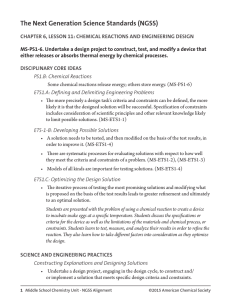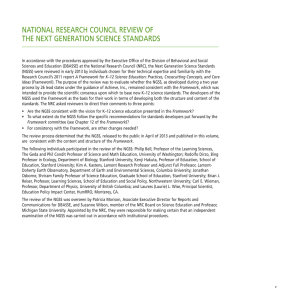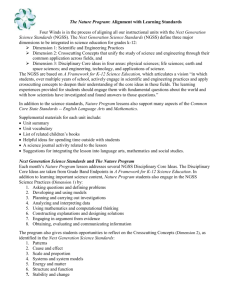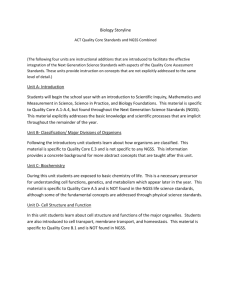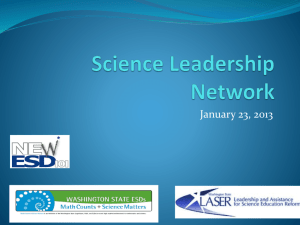A Addressing Three Common Next Generation Science Standards
advertisement
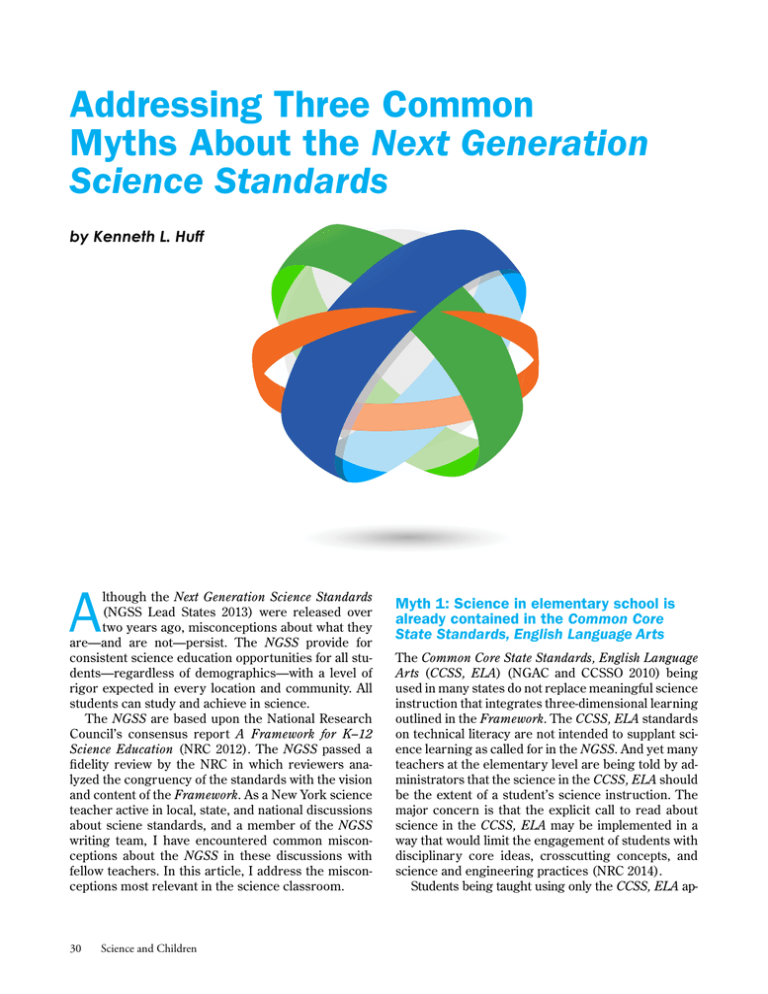
Addressing Three Common Myths About the Next Generation Science Standards by Kenneth L. Huff A lthough the Next Generation Science Standards (NGSS Lead States 2013) were released over two years ago, misconceptions about what they are—and are not—persist. The NGSS provide for consistent science education opportunities for all students—regardless of demographics—with a level of rigor expected in every location and community. All students can study and achieve in science. The NGSS are based upon the National Research Council’s consensus report A Framework for K–12 Science Education (NRC 2012). The NGSS passed a fidelity review by the NRC in which reviewers analyzed the congruency of the standards with the vision and content of the Framework. As a New York science teacher active in local, state, and national discussions about sciene standards, and a member of the NGSS writing team, I have encountered common misconceptions about the NGSS in these discussions with fellow teachers. In this article, I address the misconceptions most relevant in the science classroom. 30 Science and Children Myth 1: Science in elementary school is already contained in the Common Core State Standards, English Language Arts The Common Core State Standards, English Language Arts (CCSS, ELA) (NGAC and CCSSO 2010) being used in many states do not replace meaningful science instruction that integrates three-dimensional learning outlined in the Framework. The CCSS, ELA standards on technical literacy are not intended to supplant science learning as called for in the NGSS. And yet many teachers at the elementary level are being told by administrators that the science in the CCSS, ELA should be the extent of a student’s science instruction. The major concern is that the explicit call to read about science in the CCSS, ELA may be implemented in a way that would limit the engagement of students with disciplinary core ideas, crosscutting concepts, and science and engineering practices (NRC 2014). Students being taught using only the CCSS, ELA ap- proach miss the opportunity to develop and use models, plan and carry out investigations, and engage in argument from evidence. They cannot come close to experiencing the vision for science and engineering education articulated in the Framework and NGSS. The shift should be from teaching about science to engaging students in science and engineering practices. In this vision, core ideas are used as evidence in scientific arguments and to support explanations. The focus moves from the memorization of content to the understanding and application of ideas. Being literate in science and engineering requires one to possess skills in reading, understanding, obtaining, evaluating, and communicating information. But this is only one of the eight practices specified in the Framework and NGSS. The Framework points out that even if a student has developed grade-appropriate reading skills, just reading about science is often challenging to students. Three reasons are: • Science texts make extensive use of complex sentence structure and passive voice. They contain special words that are essentially unfamiliar. Often, these special words are ambiguous to students. • Reading a science text is quite different from reading a novel or newspaper. The precise meaning of each word or clause may be important. Therefore, science texts must be read to extract information accurately. • Science texts are multimodal, using a mix of words, graphs, diagrams, tables, and mathematics to communicate information. Understanding science requires more than simply knowing the meanings of technical terms (NRC 2012). Stage et al. (2013) assert that concurrent development in CCSS, ELA and CCSS, Mathematics has provided an opportunity to enhance literacy and math processes and proficiencies from a science education perspective. Goals for literacy, math, and science education may build students’ capacity to engage in argument from evidence. The shift from doing more than just reading science texts should not be interpreted to mean that reading is not important in science. The NGSS should be viewed as working in tandem with standards for mathematics and English language arts. Appendix M of the NGSS (2013) states that “literacy skills are critical to building knowledge in science.” The lead states and writers of the NGSS were deliberate in our efforts to identify these connections. For example, the important science and engineering practice of engaging in argument from evidence states that students should “critique the scientific explanations proposed by peers by citing relevant evidence about the natural and designed world.” In grades 3–5, students accomplish this goal by using data to evaluate claims about cause and effect (see Appendix F of the NGSS). The above type of complementarity may have its greatest benefit at the elementary level, where students are often in self-contained classrooms and teachers have too many standards in different disciplines to address. Teachers are often frustrated by all they have to teach. By cultivating the complementarity between mathematics standards, English standards, and science standards, teachers can effectively bridge gaps between disciplines. As a result, students will have increased learning opportunities, while teachers can sharpen the focus on big ideas as contained in the NGSS. Myth 2: We are already doing this There are really two myths that fall under this domain. The first myth is that if a curriculum addresses the content (traditionally defined as the concepts in life, Earth and space, and physical science) of the NGSS, then it is “doing NGSS.” While it may be true that some teachers have implemented NGSS innovations, Bybee (2013) posits this response often refers to a single dimension, such as disciplinary core ideas, instead of the three-dimensional learning approach described in the Framework and NGSS. The Framework distilled and limited core ideas across grade levels to provide teachers with opportunities to engage students in deeper understanding. This deeper understanding provides students with the tools to make sense of phenomena through integrating crosscutting concepts and science and engineering practices with disciplinary core ideas. Instructional planning benefits from the development of appropriate strategies that establish conditions for student performances of the science and engineering practices and a systematic development of proficiency at using core ideas and crosscutting concepts (Moulding, Bybee, and Paulson 2015). Designing three-dimensional learning experiences in this context requires careful attention to instructional supports for engaging students in the practices of science. For example, in teaching a unit on the reasons for seasons at the middle school level, students may use a handheld model of Earth to observe changes in the amount of light energy reaching each hemisphere as the model moves around a light source. These observations can provide the impetus for students to talk about what they do and do not understand. In their talk, students may describe how daylight hours are different at vari- January 2016 31 ous latitudes. This may then lead to an exercise where students graph hours of daylight at select latitude locations in each hemisphere. The completed graph would show a symmetrical pattern of how day length changes are more dramatic farther from the equator and that the northern and southern hemisphere day length changes—and seasons—are opposite one another during the year. Just limiting students to learning about discrete facts without opportunities for classroom dialogue, reflection on cause-and-effect relationships, or direct investigation of the phenomena leads to an impoverished understanding of core ideas. Memorizing lists of science facts (e.g., equinox or solstice) or what scientists (e.g., Copernicus or Ptolemy) discovered in the past does not provide the necessary engagement that will produce rich, interconnected knowledge and reasoning capabilities for students. The Framework emphasizes that learning science and engineering involves integrating the knowledge of scientific explanations (content knowledge) and practices needed to engage in scientific inquiry and engineering design. The second myth in this domain is that having students doing hands-on inquiry activities qualifies as three-dimensional learning in which students engage in scientific practices. Some teachers have been inclined to think science and engineering practices are simply scientific inquiry with a new name or equivalent to teaching “the scientific method.” Reiser (2013) states that such views miss the emphasis the NGSS places on talk and argument in the classroom and on analysis and reasoning as part of the scientific and engineering practices. The Framework and NGSS articulate practices to better specify what is meant by inquiry in science and the range of cognitive, social, and physical practices it requires. The beauty of the eight practices is they provide distinct and specific abilities of scientific inquiry and delineate in greater detail what scientists (and what I want my students to) do to gain a better understanding of the natural world. Existing activities may appear to be aligned with conceptual shifts in the NGSS because they are “hands on” but often miss the mark because they do not address building and testing explanatory ideas. Science teachers often have a repertoire of ideas and activities they have found to be effective. While each of these activities may still be useful, it is necessary to reexamine and possibly eliminate familiar units or activities to ensure students are engaged at the nexus of threedimensional science learning (NRC 2015). Simply checking off an activity without analysis of its threedimensionality will not suffice for implementing the 32 Science and Children vision of the NGSS. To engage in the practices, new instructional units that intertwine core ideas, practices, and crosscutting concepts will need to be implemented. As teachers, we are being called to think about how to involve our students in using science and engineering practices and crosscutting concepts to develop and apply the disciplinary core ideas of science. The focus is not on the three dimensions but rather on threedimensional learning and how knowledge and practices must be intertwined in designing student learning experiences. Myth 3: NGSS limits what science can be taught in middle and high school In the 1990s, as a result of products such as Benchmarks for Science Literacy and the National Science Education Standards, the educational maxim “less is more” became widespread. This phrase reminded us that as teachers we need to reserve time for exploration and discovery. Nineteen years of science education research and the publication of additional National Research Council consensus reports including Ready, Set, Science! (NRC 2008) reinforce this point. Any attempt to assess all the material in the NGSS disciplinary core ideas will inevitably mean that the key goal of the NGSS—teaching how to do science—will be lost. The NGSS serve as a benchmark for all students and should be seen as the floor, not the ceiling. The NGSS represent the knowledge that all students require to be scientifically literate as indicated by the Framework. Previous national standards documents were also designed to be a floor rather than a ceiling. Most states have high school standards that are course based, describing what students who take a particular course should know. The NGSS are a set of standards developed by a 26-state collaborative using research described in the Framework to delineate what all students should know and be able to do in terms of student performance. This is a point of departure from most prior standards documents. Exactly how much students can learn is difficult to determine. Clearly, students have strengths as they learn, and some will learn more than others. For example, a student who aspires to be a medical doctor will need to learn more biology than those who do not want to be a doctor. Given that students can’t learn everything, we must prioritize what is to be learned. The question then becomes how does one decide what ideas all students should learn? The Framework has helped us answer this question. Standards are not meant to limit what is taught; rather, they ensure the most useful ideas are taught. If, and when, students ADDRESSING THREE COMMON MYTHS ABOUT THE NEXT GENERATION SCIENCE STANDARDS have learned these most useful ideas, it is appropriate to help them learn other ideas. The Framework asserts that because of the continuing expansion of science knowledge, it is impossible to teach all ideas related to a given discipline in exhaustive detail during the K–12 years. Information is ubiquitous—virtually at the touch—and an important role of science education is not to teach students “all the facts” but rather prepare them with sufficient core knowledge so they can later acquire additional information on their own. Some teachers have argued content must be added back to the NGSS because important material has been omitted. A reviewer of an early draft of the NGSS commented to the writing team that key Earth science topics—like the rock cycle—were missing from the standards, but in fact they are part of the disciplinary core ideas and clarification statements. Consider the clarification statement for MS-ESS2-1 in the NGSS: “Emphasis is on the process of melting, crystallization, weathering, deformation, and sedimentation, which act together to form minerals and rocks through the cycling of Earth’s materials.” Disciplinary core ideas are not a list of topics to cover. They neither mandate nor omit specific topics of study. This becomes the purpose of a state or district curriculum framework. Curriculum frameworks do not involve changing the NGSS performance expectations. Requiring that more content be added and therefore “covered” will be detrimental to teachers and students. The approach of first making sure all students are proficient in the NGSS performance expectations and then providing opportunities for advanced students to enter AP or IB classes has much merit. It should not be implied that you cannot teach additional material after reaching all of the NGSS performance expectations. Forthcoming NGSS resources will include accelerated model course pathways and model content frameworks to provide further guidance in this area. Conclusion Science education is central to the lives of all Americans. Students face a world where they will frequently be required to make important decisions on issues that range from health care to the environment. Achieving literacy in science will require coherence at all levels and across components of the system including curriculum, assessment, and professional development (NRC 2015). Coordinating changes in all aspects of the system will be challenging, but it is not impossible. At stake is our children’s ability to make wise personal decisions and to compete and lead in a global economy. ■ Acknowledgement A special thank you to Dr. Bruce Alberts for his insights on this article. References Bybee, R.W. 2013. Translating the NGSS for classroom instruction. Arlington, VA: NSTA Press. Moulding, B.D., R.W. Bybee, and N. Paulson. 2015. A vision and plan for science teaching and learning: An educator’s guide to A Framework for K–12 Science Education, Next Generation Science Standards, and state science standards. Salt Lake City: Essential Teaching and Learning Publications. National Governors Association Center for Best Practices and Council of Chief State School Officers (NGAC and CCSSO). 2010. Common core state standards. Washington, DC: NGAC and CCSSO. National Research Council (NRC). 2008. Ready, set, science! Putting research to work in K–8 science classrooms. Washington, DC: National Academies Press. National Research Council (NRC). 2012. A framework for K–12 science education: Practices, crosscutting concepts, and core ideas. Washington, DC: National Academies Press. National Research Council (NRC). 2014. Developing assessments for the Next Generation Science Standards. Washington, DC: National Academies Press. National Research Council (NRC). 2015. Guide to implementing the Next Generation Science Standards. Washington, DC: National Academies Press. NGSS Lead States. 2013. Next Generation Science Standards: For states, by states. Washington, DC: National Academies Press. Reiser, B.J. 2013. What professional development strategies are needed for successful implementation of the Next Generation Science Standards? Paper written for the Invitational Research Symposium on Science Assessment, Educational Testing Service, Washington, DC. www.k12center.org/rsc/pdf/reiser.pdf. Stage, E.K., H. Asturias, T. Cheuk, P.A. Daro, and S.B. Hampton. 2013. Opportunities and challenges in Next Generation Standards. Science 340 (6130): 276–277. Kenneth L. Huff (khuff@williamsvillek12.org) is a science and math teacher at Mill Middle School in Williamsville, New York. He is a member of the NSTA board of directors and serves as division director of Middle Level Science Teaching. January 2016 33



